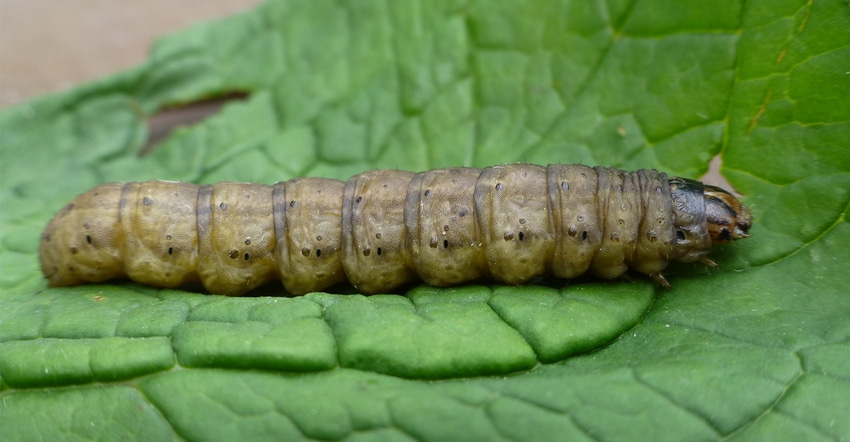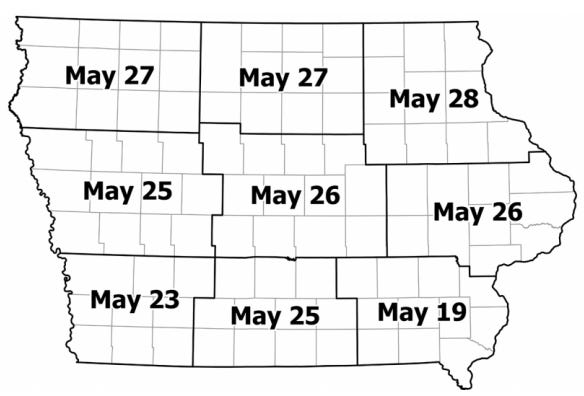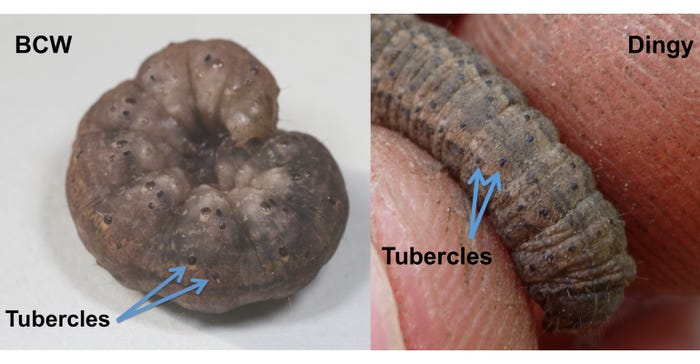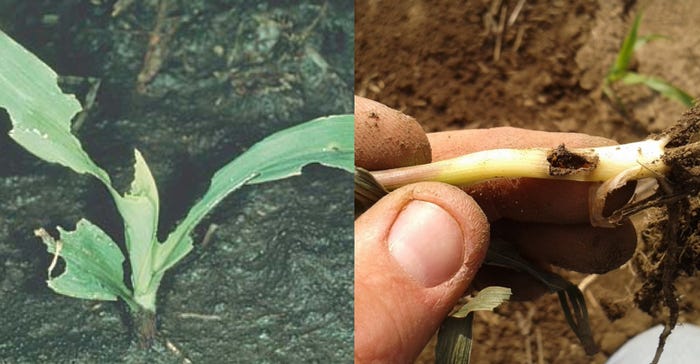May 15, 2020

Black cutworm is a migratory pest that arrives in Iowa with spring storms each year. After flying in from the southern U.S., BCW moths lay eggs in and near crop fields. The eggs hatch and the larvae that emerge can cut corn seedlings or feed on leaves of young corn plants. Even though cornfields were planted earlier this year than in previous years, cold temperatures this spring may slow the growth of corn seedlings and allow the BCW larvae to coincide with early vegetative stage corn that is vulnerable to cutworm injury.
BCW is a sporadic pest, making it essential to scout to determine whether management, such as spraying an insecticide treatment, is required. Erin Hodgson, ISU Extension entomologist, and Ashely Dean, ISU Extension program specialist, provide the following information and recommendations.
When to scout for BCW larvae is based on when a “significant flight” of moths arrives in Iowa. The accumulation of degree days after this significant flight can be used to predict when BCW eggs will hatch and larvae will be active. A flight is considered significant when eight or more BCW moths are captured in a wing-style pheromone trap over two consecutive nights.
ISU has established 39 BCW traps working with 36 cooperators in 34 counties around the state this year. These cooperators monitor pheromone traps and report moth captures to ISU Extension entomologists to track moth movement in Iowa.
This year BCW moths were reported almost immediately after cooperators began checking traps April 1. Moth captures continued through April, with one peak flight occurring in Washington County in southeast Iowa on April 12, and subsequent peak flights in Washington County and Marshall County in central Iowa on April 28.
Start scouting cornfields soon
Even though only two counties reported significant flights earlier in April, statewide BCW moth captures increased dramatically during the week of April 26.
The map of Iowa shows the predicted cutting dates for BCW for each crop reporting district. These cutting dates are predicted using actual and historical degree day data combined with the occurrence of peak flights during April. Predictions are made using the most accurate data available to ISU Extension entomologists. BCW trapping will continue through May, and any additional peak flights that occur will be included in ISU’s weekly ICM updates.

PREDICTED CUTTING: Estimates of when black cutworm will likely begin cutting corn plants in each Iowa crop reporting district are based on peak moth flights in April. (Source: ISU Extension)

Capturing BCW moths in a pheromone trap does not necessarily mean there will be economic infestations in a particular location. Scouting fields is the only way to determine if BCW is present and whether management is warranted.
Correctly identifying cutworms
BCW larvae have grainy, light-gray to black skin and four pairs of fleshy prolegs at the end of the abdomen. There are pairs of dark tubercles, or bumps, along the sides of the body. The tubercles are used to distinguish BCW from other similar cutworm species, like dingy cutworm. Dingy cutworm rarely causes economic injury in corn. On each body segment, the tubercle closest to the head is about a third the size of the tubercle closest to the rear for BCW; the corresponding tubercles on each segment for dingy cutworm are roughly the same size.

DIFFERENCES: Black cutworm (left) can be distinguished from other larvae, such as dingy cutworm (right), by the dark tubercles along their bodies. For black cutworm, the tubercles nearest the head on each segment are about a third the size of the tubercle closest to the rear. Corresponding tubercles on dingy cutworm are about the same size.

The Field Crop Insects publication from the ISU Extension Store can aid in identification of other cutworm species. You want to be able to tell the difference between black cutworm and dingy cutworm when scouting, so you can make the best management decision if you find cutworms present. There’s no need to spray an insecticide if you have dingy cutworm, because they don’t clip off corn plants. They just chew on the leaves of the young corn plants. But if black cutworm is present and is at the economic threshold, you will need to treat.
Scouting for black cutworm
Poorly drained, low lying fields or weedy fields may have a higher risk of BCW injury to young corn plants. Additionally, fields near natural vegetation, fields with reduced tillage, or fields with cover crops may be at higher risk. Green cover crops are attractive to egg-laying females. Late-planted or slow-growing corn plants are typically smaller and more vulnerable to larval feeding. Some Bt corn hybrids provide BCW suppression (hybrids with the Vip3A and Cry1F traits); see The Handy Bt Trait Table. However, keep in mind that the larvae can still cut young plants. Suppression doesn’t mean complete control.
Keep an eye on fields as soon as corn starts to emerge. Begin scouting at least a few days before estimated cutting dates. Early scouting is important because local larval development varies due to weather variation within a climate division, and additional significant flights could prolong the arrival of BCW larvae to a field. Fields should be scouted weekly (every seven to 10 days) until corn reaches V5 growth stage.
Examine 10 corn plants in five areas of the field (50 total plants). Look for wilting, leaf discoloration or damage, and missing or cut plants. BCW larvae sometimes drag cut plants under soil clods to continue feeding during the day. Flag the areas of fields where there is suspected BCW feeding and return later to assess further injury.

CUTTING CORN: Black cutworm can clip off corn seedlings. Injury from the larvae usually begins above the soil surface. Leaf feeding can occur (left), or larvae can severely damage or kill plants (right).

Take note of plant growth stage and the size of larvae in the field; this will help determine how long larvae may continue to injure plants. Larvae can be found by carefully excavating the soil around a damaged plant. BCW larvae are nocturnal feeders and will hide in the soil during the day. Remember to watch for indications of other early-season pests such as wireworms, white grubs and seed corn maggot.
Thresholds and management
The generic economic threshold for treating BCW in corn is when 2% to 3% of the plants are cut when larvae are less than 0.75 inch long. It’s when 5% of plants are cut when larvae are greater than 0.75 inch long. However, this threshold can be adjusted depending on corn price, final corn stand and input costs. A dynamic threshold calculator for BCW can be used to aid management decisions.
Instead of using a rescue type of insecticide treatment, how about applying a preventive insecticide treatment to a cornfield? Preventive insecticide treatments are a questionable practice. Rescue treatments are usually the most efficient and economical approach to managing BCW since it is a sporadic pest. Be sure to scout to determine that the larvae are still present in the field before spraying insecticides for BCW.
Iowa has experienced a lot of fluctuating temperatures this spring, including some freezing temperatures after black cutworm arrived in the state. Young larvae, pupae and adults are not expected to survive when exposed to subfreezing temperatures. Eggs and older larvae (fourth to sixth instars) are the most cold-hardy stages of BCW; they may survive weeks below freezing. If eggs are laid but have not yet hatched, they will likely survive, but development may be slowed and cutting may occur later than predicted.
Report larvae
If you see any fields with BCW larvae or injury while scouting, let the ISU Extension entomologists at Ames know. Or in your area of the state, let your ISU Extension field agronomist know. You can send a message or photo of the BCW larvae to the ISU entomologists at [email protected]. This information will help them refine their cutting predictions and scouting recommendations in the future.
To keep up to date on the Iowa Moth Trapping Network, check for weekly updates on the ISU integrated crop management web page at ICM Blog or subscribe to the ICM e-newsletter to receive email notifications.
Source: ISU, which is solely responsible for the information provided and is wholly owned by the source. Informa Business Media and all its subsidiaries are not responsible for any of the content in this information asset.
You May Also Like




